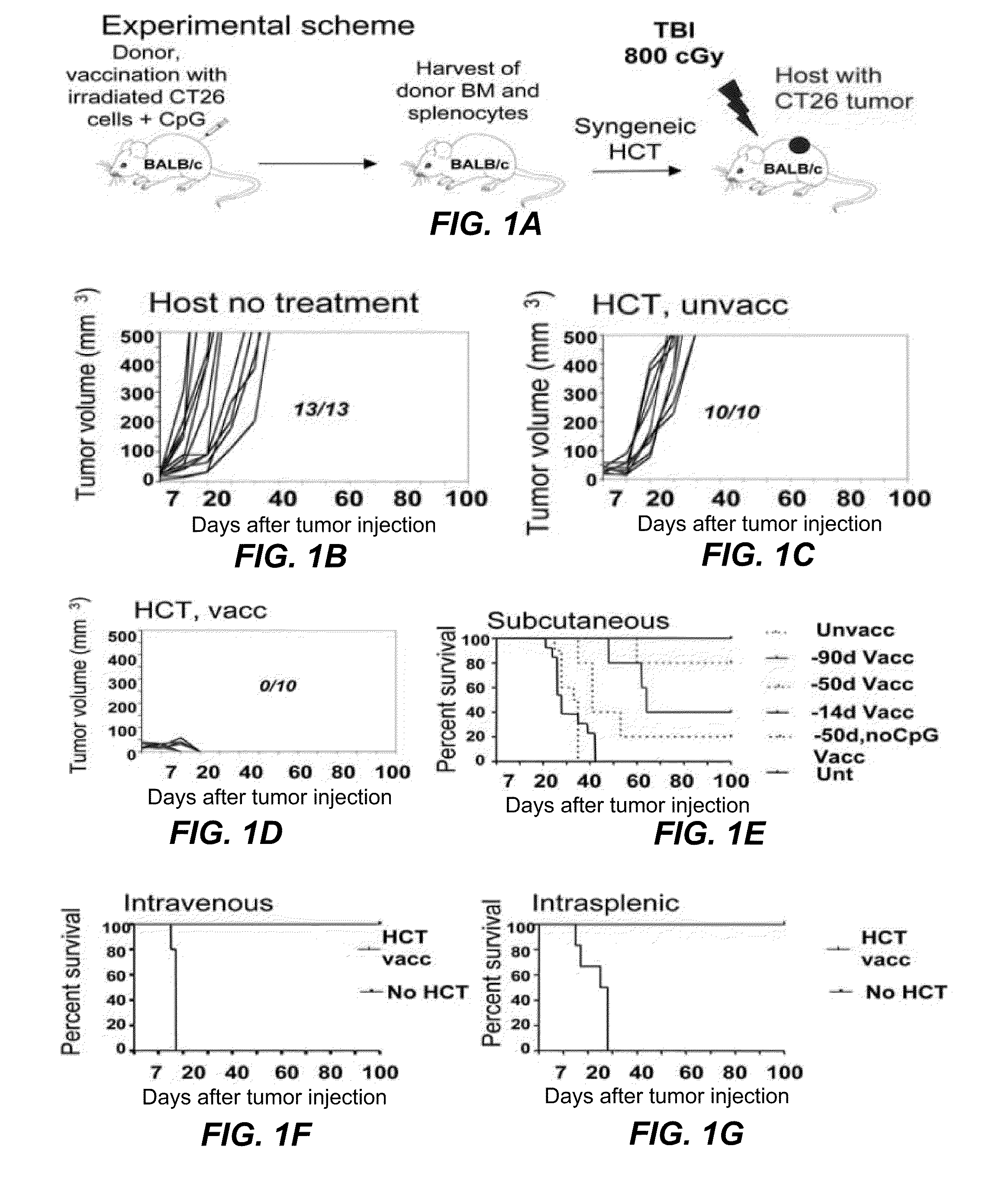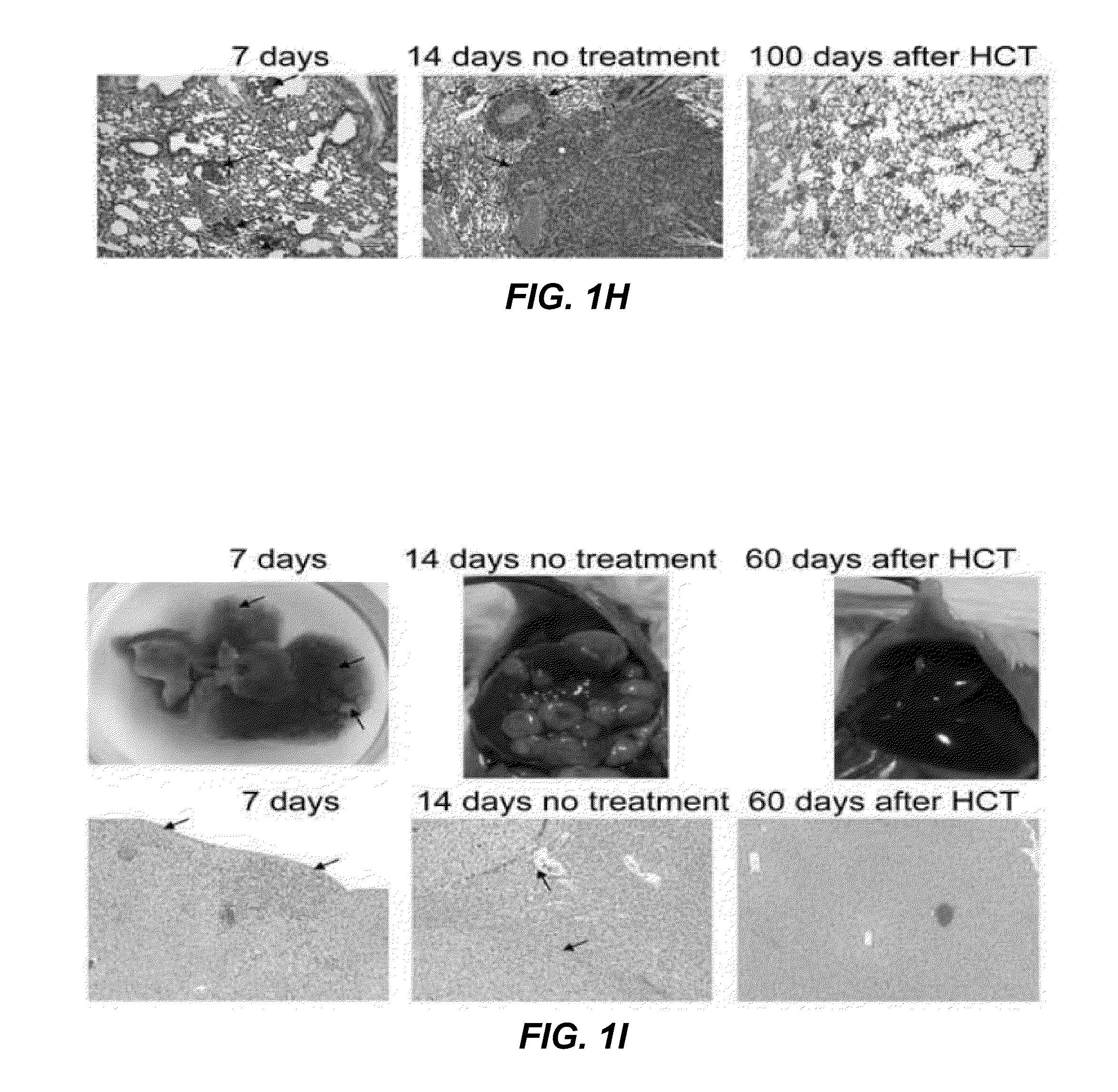Tumor vaccination in combination with hematopoietic cell transplantation for cancer therapy
a cancer therapy and hematopoietic cell technology, applied in the direction of antibody medical ingredients, drug compositions, immunological disorders, etc., can solve the problems of affecting the treatment effect of cancer, affecting the production of blood cells, and affecting the treatment effect of many types of cancers or cancers, so as to achieve the effect of reducing side effects
- Summary
- Abstract
- Description
- Claims
- Application Information
AI Technical Summary
Benefits of technology
Problems solved by technology
Method used
Image
Examples
example 1
Hematopoietic Cell Transplantation (HCT) from Vaccinated BALB / c Donor Mice Cures Established CT26 Colon Tumors
[0115]FIG. 1A shows the experimental scheme, which uses HCT from tumor-vaccinated donors to treat CT26 colon tumors in syngeneic mice. In all instances, normal BALB / c donor mice were vaccinated subcutaneously (s.c.). with 106 irradiated CT26 tumor cells mixed with 30 μg CpG, an adjuvant that stimulates antigen presenting cell via TLR-9 (12,13). After 90 days, spleen and bone marrow cells were harvested, and transplanted intravenously (i.v.) into tumor-bearing BALB / c host mice following a single dose of total body irradiation (TBI). Seven days prior to TBI, hosts had been given live tumor cells via s.c. (2.5×104), i.v. (2×105) or intrasplenic (5×105) routes. FIG. 1B shows the progressive growth of s.c. tumors in all untreated mice. Similarly, tumor bearing recipients of 50×106 bone marrow cells and 60×106 spleen cells from unvaccinated donors had uniformly progressive tumors ...
example 2
Vaccination and HCT Induces Long-Term Anti-Tumor Immunity
[0117]To assess the duration of effect of vaccination combined with HCT, “cured” animals from the experiment in FIG. 1D were challenged with 2.5×104 live tumor cells at day 120 as shown in the experimental scheme in FIG. 2A. The results show that these animals were completely protected and survived for at least 100 days (FIG. 2A). Moreover, harvesting of spleen and bone marrow cells from “cured” recipients at day 180 after HCT, and secondary transfer resulted in 80% of the new recipients surviving for more than 100 days (FIG. 2B). At least 100 days later those secondary recipients were used as donors for another HCT into irradiated tumor-bearing tertiary hosts which was also effective since all tertiary hosts survived more than 100 days (FIG. 2B). Thus, anti-tumor immunity generated by a single vaccination could eradicate tumors 370 days later (FIG. 2B).
example 3
Tumor Eradication Requires Lethal Irradiation of Hosts, as well as Transferof CD4+ and CD8+ T Cells from Vaccinated Donors
[0118]FIG. 3A illustrates the significant role of the host conditioning regimen in our vaccine strategy. All tumor bearing recipients of bone marrow and splenocytes from vaccinated donors were cured when conditioned with myeloablative TBI (800 cGy). In contrast, only 60% of hosts survived 100 days with a non-myeloablative radiation dose (450 cGy) (p− / − recipients that lack T cells. Rag 2− / − BALB / c hosts were given myeloablative radiation or no radiation immediately before transplantation of cells from vaccinated donors. FIG. 3B shows that although there was a significant delay in mortality in non-irradiated Rag 2− / − mice as compared to non-irradiated wild type mice (p=0.001), all mice died by day 65. Conditioning of the Rag 2− / − mice with 800 cGy resulted in significant improvement in survival as compared to the non-irradiated mice (p=0.001), and all hosts surviv...
PUM
| Property | Measurement | Unit |
|---|---|---|
| diameter | aaaaa | aaaaa |
| median survival time | aaaaa | aaaaa |
| median survival time | aaaaa | aaaaa |
Abstract
Description
Claims
Application Information
 Login to View More
Login to View More - R&D
- Intellectual Property
- Life Sciences
- Materials
- Tech Scout
- Unparalleled Data Quality
- Higher Quality Content
- 60% Fewer Hallucinations
Browse by: Latest US Patents, China's latest patents, Technical Efficacy Thesaurus, Application Domain, Technology Topic, Popular Technical Reports.
© 2025 PatSnap. All rights reserved.Legal|Privacy policy|Modern Slavery Act Transparency Statement|Sitemap|About US| Contact US: help@patsnap.com



